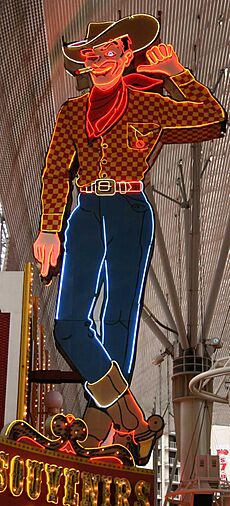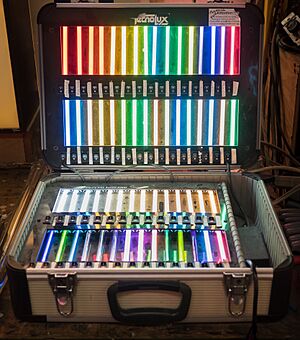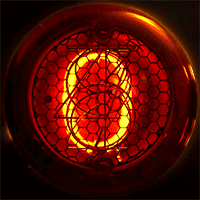Neon lighting facts for kids
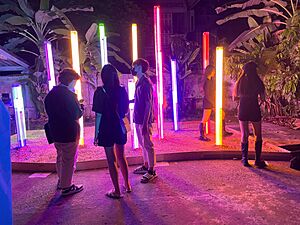
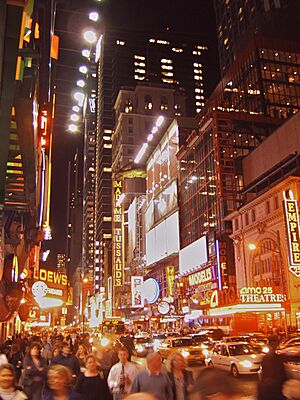
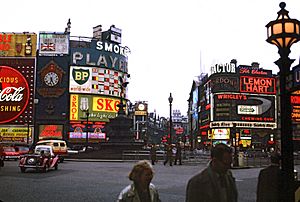
Neon lighting uses bright, glowing glass tubes or bulbs. These tubes have a special gas inside, like neon. Neon lights are a type of "cold cathode" light. This means they don't need to get hot to glow. Each neon tube is a sealed glass tube with a metal part called an electrode at each end. The tube is filled with a gas at low pressure. When a high electric power (thousands of volts) is sent through the electrodes, it makes the gas inside glow. This process is called ionizing the gas.
The color of the light depends on the gas inside the tube. Neon gas itself gives off a popular orange light. But other gases and chemicals called phosphors can make different colors. For example, hydrogen makes purple-red, helium makes yellow or pink, and carbon dioxide makes white. Mercury gas can make blue light. Neon tubes can be bent into cool shapes, like letters or pictures. They are mostly used to make colorful, eye-catching signage for advertising. These are called neon signs. They were very popular from the 1920s to the 1960s, and again in the 1980s.
The term "neon lighting" can also mean tiny neon glow lamps. These were invented in 1917. While large neon tubes are often many meters long, neon lamps can be less than one centimeter. They glow much more softly than the big tubes. Today, they are still used as small indicator lights. In the past, until the 1970s, neon glow lamps were used for numbers in electronics. They also appeared in small decorative lamps and in electronic circuits. Even though these lamps are now old, their technology helped create modern plasma displays and televisions.
Contents
Who discovered neon and how did it become popular?
Neon was found in 1898 by two British scientists. Their names were William Ramsay and Morris W. Travers. They got pure neon gas from the air. Then, they studied its properties using a special glass tube. This tube was called an "electrical gas-discharge" tube. It was similar to the tubes used for neon signs today.
Georges Claude, a French engineer, showed off neon tube lighting in its modern form. This happened at the Paris Motor Show in December 1910. Claude, sometimes called "the Edison of France," had almost complete control over this new technology. It became very popular for signs and displays from 1920 to 1940. Neon lighting was a big part of American culture during that time. By 1940, almost every city in the US had downtown areas bright with neon signs. Times Square in New York City was famous worldwide for its amazing neon displays. There were 2,000 shops across the country making neon signs.
After World War II (1939–1945), the popularity of large neon signs for advertising went down in the U.S. But it kept growing strong in Japan, Iran, and other countries. In recent years, architects and artists have started using neon tube lighting again. They use it as a cool part of their art and building designs.
How does neon lighting work?
Neon lighting is similar to fluorescent lighting. Fluorescent lights were developed about 25 years after neon tube lights. In fluorescent lights, the light from gases inside a tube makes special materials glow. These materials coat the inside of the tube. They then shine with their own colors, usually white. Fluorescent coatings (phosphors) can also be used for neon tube lighting. They are often chosen to make very bright colors.
The science behind the glow

Neon is a noble gas chemical element. It's also an inert gas, meaning it doesn't easily react with other elements. Neon is a small part of Earth's atmosphere. When Ramsay and Travers got pure neon, they put it in a special tube. This "electrical gas-discharge" tube was like the ones used for neon signs now. Travers later wrote that "the blaze of crimson light from the tube told its own story." He said it was a sight to remember. Scientists at the time knew that the colors of light from these tubes were like "fingerprints." They could identify the gases inside.
Right after neon was found, neon tubes were used for science and as cool new items. But pure neon gas was hard to get. So, it wasn't used much for lighting at first. Other lights, like Moore tubes, used more common gases like nitrogen or carbon dioxide. These had some success in the US in the early 1900s.
After 1902, Georges Claude's company in France, Air Liquide, started making large amounts of neon. It was a leftover product from their air liquefaction business. From December 3 to 18, 1910, Claude showed two large, bright red neon tubes. They were about 12 meters (40 feet) long. This happened at the Paris Motor Show.
These neon tubes were very much like the ones we see today. The glass tubes used for neon lighting are usually 9 to 25 millimeters (about 0.35 to 1 inch) wide. With normal electrical equipment, the tubes can be as long as 30 meters (100 feet). The gas pressure inside is very low, like a partial vacuum. Claude also solved two problems that made neon tubes last longer. This helped create the neon lighting industry. In 1915, Claude got a US patent for the design of the electrodes. This patent gave his company, Claude Neon Lights, a monopoly on neon signs in the US until the early 1930s.
Claude's patents also included using gases like argon and mercury vapor to make different colors. For example, mixing mercury with neon gas makes blue. Green can be made using special yellow glass. White and gold can be created by adding argon and helium. In the 1920s, new fluorescent glasses and coatings were made. These expanded the colors and effects for tubes with argon gas or argon-neon mixes. Usually, fluorescent coatings are used with an argon/mercury-vapor mix. This mix gives off ultraviolet light, which makes the coatings glow. By the 1930s, neon tube lights could make good colors for some indoor lighting. They were popular in Europe but not as much in the US. Since the 1950s, new phosphors for color televisions have created almost 100 new colors for neon tube lighting.
Around 1917, Daniel McFarlan Moore at General Electric Company developed the tiny neon lamp. This glow lamp is very different from the larger neon tubes for signs. It was so different that a separate US patent was given for the lamp in 1919. A Smithsonian Institution website says these small lamps use a "coronal discharge" principle. Moore put two electrodes close together in a bulb and added neon or argon gas. The electrodes would glow brightly in red or blue, depending on the gas. These lamps lasted for years. Since the electrodes could be shaped almost any way, they were popular for fun decorative lamps. Glow lamps were also used as electronic parts. They were indicators in control panels and many home appliances until light-emitting diodes (LEDs) became popular in the 1970s.
Even though some neon lamps are now antiques, their technology has continued to grow. Neon lighting has changed from long tubes into thin flat panels. These are used for plasma displays and plasma television sets.
Neon tube lighting and signs: A bright history

When Georges Claude showed his impressive neon tube lighting in 1910, he thought it would be used just for general lighting. Claude's demonstration in Paris lit up a large exhibition hall. But Claude's friend, Jacques Fonseque, saw how great it could be for signs and advertising. By 1913, a huge sign for Cinzano vermouth lit up the night sky in Paris. By 1919, the entrance to the Paris Opera was decorated with neon tube lighting.
Neon signs were especially loved in the United States. In 1923, Earle C. Anthony bought two neon signs from Claude for his Packard car dealership in Los Angeles, California. These signs were so bright they actually stopped traffic! Claude's US patents gave him a monopoly on neon signs. After Anthony's success, many companies made deals with Claude to make neon signs. Often, companies got special rights to make neon signs in a certain area. By 1931, the neon sign business was worth $16.9 million. A lot of this money went to Claude Neon Lights, Inc. through these deals. Claude's main patent ended in 1932. This led to a huge increase in neon sign production. The industry's sales in 1939 were about $22.0 million. The number of signs made grew much more than the sales figures suggest.
Rudi Stern wrote that the 1930s were a very creative time for neon. Many design and animation tricks were developed then. People like O. J. Gude and Douglas Leigh took neon advertising further than Georges Claude had ever imagined. Leigh created the famous Times Square spectaculars. He even tried displays that included smells, fog, and sounds. Much of the excitement of Times Square in the 1930s came from Leigh's artistic genius. Major cities in the US and other countries also had amazing neon sign displays. Events like the Chicago Century of Progress Exposition (1933–34) and the New York World's Fair (1939) used neon tubes a lot in their buildings. Stern said that the "glorious" neon displays for movie theaters made people connect movies with neon. "One's joy in going to the movies became inseparably associated with neon."
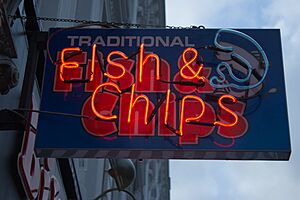
World War II (1939–1945) stopped new sign installations around most of the world. After the war, the industry started up again. Marcus Thielen wrote that after World War II, programs helped re-educate soldiers. The Egani Institute in New York City was one of the few schools that taught neon-trade secrets. The American design style of the 1950s would be hard to imagine without neon. The growth of Las Vegas, Nevada as a resort city is strongly linked to neon signs. Tom Wolfe wrote in 1965 that Las Vegas was the only city whose skyline was made of signs, not buildings or trees. He said, "One can look at Las Vegas from a mile away on route 91 and see no buildings, no trees, only signs. But such signs! They tower. They revolve, they oscillate, they soar in shapes before which the existing vocabulary of art history is helpless."
However, neon displays became less popular overall. Some cities even made rules against building them. Nelson Algren named his 1947 short story collection The Neon Wilderness. He used it as a way to describe the "urban jungle" of Chicago. Margalit Fox wrote that after World War II, neon signs were replaced more and more by plastic signs with fluorescent lights. The art of bending colored tubes began to fade. This "Dark Age" lasted until the 1970s, when artists started using neon with excitement. In 1979, Rudi Stern published his book, Let There Be Neon. Marcus Thielen wrote in 2005 that the demand for neon and cold cathode in buildings is growing. He also said that new technologies like fiber optics and LEDs have made neon technology stronger, not replaced it. The story of the neon tube is still being written, 90 years after the patent was filed.
Neon glow lamps and plasma displays
In neon glow lamps, the glowing part of the gas is a thin area. It's called the "negative glow" region. It's right next to the negatively charged electrode, called the "cathode." The positively charged electrode, the "anode," is very close to the cathode. These features make glow lamps different from the much longer and brighter neon tubes used for signs. The lamps use very little power when they glow (about 0.1 W). That's why they are called cold-cathode lighting.
Some ways neon lamps are used:
- Pilot lamps: These show if an appliance or instrument has electrical power. For example, on a coffee pot or power supply.
- Decorative lamps: In these, the cathode is shaped like a flower or animal. The shapes inside were often painted with special glow-in-the-dark paints to make different colors. The Aerolux Light Corporation was a famous maker of these lamps.
- Electronic circuits: They were used in things like electronic oscillators, timers, and memory parts.
- Complex electronic displays: Like the Nixie tube (see picture).
The small size of the neon lamp's glow region and its flexible electronic uses led to this technology being used for the first plasma panel displays. The first black-and-white plasma panel displays were made in 1964 at the University of Illinois. They were for the PLATO educational computing system. They had the typical color of a neon lamp. Their inventors, Donald L. Bitzer, H. Gene Slottow, and Robert H. Wilson, made a computer display that could remember what was on it. It didn't need constant updates from the main computer.
The connection between these early displays and today's color plasma displays and televisions was explained by Larry F. Weber in 2006. He said, "All plasma TVs on the market today have the same features that were demonstrated in the first plasma display." These features include how the voltage works, a special layer, and a neon-based gas mix. Like colored neon lamps, plasma displays use a gas mix that gives off ultraviolet light. Each tiny dot (pixel) has a phosphor that glows one of the display's main colors: red, green, or blue.
Neon lighting and artists

The mid to late 1980s saw a comeback in neon production. Sign companies created a new type of sign called channel letters. These were individual letters made from sheet metal.
While the market for neon lighting in outdoor advertising has gone down since the mid-20th century, artists have recently used neon lighting in their art. They use it in individual art pieces and as part of buildings. Frank Popper says that using neon lighting as the main part of artworks started with Gyula Košice's work in Argentina in the late 1940s. Other artists who used neon in their art include Stephen Antonakos, Billy Apple, Joseph Kosuth, Bruce Nauman, Martial Raysse, Chryssa, Piotr Kowalski, Maurizio Nannucci, and François Morellet. Also, Lucio Fontana and Mario Merz.
Several museums in the United States are now dedicated to neon lighting and art. These include the Museum of Neon Art (founded by neon artist Lili Lakich, Los Angeles, 1981), the Neon Museum (Las Vegas, founded 1996), and the American Sign Museum (Cincinnati, founded 1999). These museums fix and show old signs that were originally for advertising. They also have exhibits of neon art. Several books with photographs have also been published to show neon lighting as art.
Artists who use neon light
- Billy Apple (born 1935) New Zealand / USA
- Frida Blumenberg (born 1935) South Africa
- Chryssa (born 1962) Greek-American
- Michael Flechtner (born 1951) US
- Michael Hayden (born 1943) Canada
- Joseph Kosuth (born 1965) US
- Piotr Kowalski (born 1927) Poland, France
- Brigitte Kowanz (born 1957) Austria
- Lili Lakich (born 1944) US
- Mario Merz (born 1925) Italy
- Victor Millonzi (born 1915) US
- Maurizio Nannucci (born 1939) Italy
- Bruce Nauman (born 1941) US
- Carla O'Brien Australia (uses LED neon flex)
- Bill Parker (born 1950) US (plasma lamp)
- Stepan Ryabchenko (born 1987) Ukraine
- Lisa Schulte (born 1956) US
- Keith Sonnier (born 1941) US
- Rudi Stern (born 1936) US
- Tim White-Sobieski (born 1961) Poland
See also
- Crackle tube
- Plasma globe


